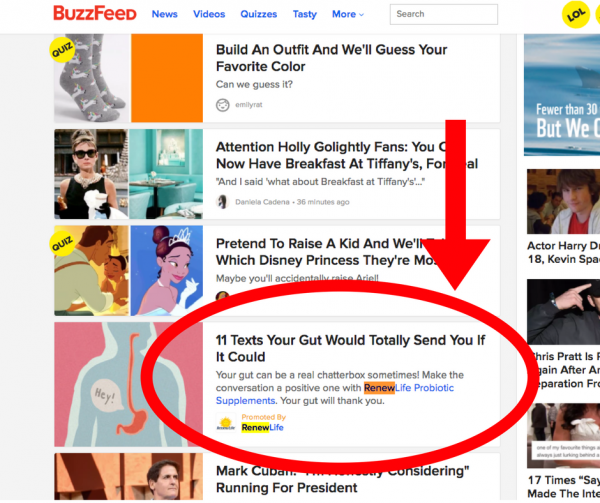Marketing in Camouflage: Native Advertising for Manufacturers
by Emily Swet
Native advertising for manufacturing brands can be a mighty tool in your marketing arsenal. And with native predicted to drive 74% of ad revenue by 2021, it’s worthy of consideration. Let’s take a closer look at the basics of native advertising to see if it’s a good fit for your manufacturing brand.
First, What Is Native Advertising?
Native advertising is an ad format that looks like the editorial content around it. It’s different from content marketing, which is unpaid and lives on your website and social channels. Instead, native ads are paid placements in publications (or their online counterparts) that offer other value to your customers.
Isn’t That Just a Fancy Word for an Advertorial?
Advertorials are similar: longer-form ads written in an editorial style to evoke the same experience as a publication they are placed in. You’ve likely heard of them – they’ve been around since the 1940s (and are the precursor to today’s infomercial). Advertorials are generally much more promotional. They usually focus on the benefits of the product/service being offered and often push to sell.
In contrast, native ads usually focus on highly targeted content from which the reader can gain value. There is less emphasis on the product behind the article, and no sales pitch. Brands gain value in return by positioning themselves as thought leaders in their industry, building trust and brand affinity.
What Are the Benefits?
- They Are Appealing. Consumers view native advertising more often then banner ads.
- They Are Empowering. When done correctly, native ads give prospects the power to find solutions to their problems.
- The Leads Are Good. Because the content is relevant and highly targeted, you get more high-quality leads. This is particularly true if you are putting native ads on the sites of niche trade publications.
What Are the Drawbacks?
- Scalability. Producing native ads can be demanding. Each ad needs to look and sound like part of its environment. That means you risk authenticity or value, especially under a deadline, if you push for quantity.
- It can be perceived as deceptive. People don’t want to be tricked. There’s a delicate balance: your content must flow naturally with the publication. But you also can’t leave your reader feeling betrayed when they notice it’s sponsored. Your content should be relevant and insightful or useful in some way.
- One bad apple spoils the bunch. There are plenty of brands creating native ads that are simply too promotional. This makes some consumers leery of native ads in general. But according to Forbes, standards for native are set to increase, making it necessary for advertisers to follow rules and regulations.
What Does This Mean for Your Brand?
To conclude, native advertising can fall right in your prospect’s wheelhouse – if it’s done right. Offer something useful to your buyer from the outset, and you’ll build loyalty and name recognition. (And pull them into your sales funnel.) But like any kind of advertising, native ads require expertise, testing, and evaluation to monitor your success rates.
Continue ReadingB2B Monday Myth: Product Demos Are Things of the Past
by MGB2B
 The Myth: No One Wants to Watch Demonstrations of Your Products.
The Myth: No One Wants to Watch Demonstrations of Your Products.
The Truth: 55% of B2B Buyers Rank Product Demos as One of the Most Influential Types of Content.
Before the days of the world wide web, your printed product brochure and instructional materials were more precious than gold to your audience. Without them, B2B buyers had no way of knowing exactly how your products worked, how they were installed and used, or how they differed from your competition’s. Today, while a Google search won’t tell your buyers everything they need to know about your products, they can probably gather enough information to make an informed buying decision without the need for a demo. Right?
A recent study performed by the Content Marketing Institute and SmartBrief revealed which types of marketing content were most important to those responsible for B2B buying decisions. When asked to rank how much influence various types of content had on their purchases, 55% of respondents placed Product Demos in their top two. With over half of B2B buyers turning to product demonstrations to help fuel their purchasing decisions, you should think twice before removing your demo videos from YouTube. After all, you are the expert when it comes to your products.
Now that you know just how valuable B2B product demos are, it might be time to consider freshening up your collection. Here are five tips to keep your demos up-to-date:
Five Tips for B2B Product Demos
- Give it real-world application. Don’t just demo your product arbitrarily. Have it solve a problem that vexes your buyers.
- Keep it simple. Though tempting, don’t overcrowd your video with too much info. Stick to two or three of the most helpful features and common uses, and you’ll strike a compelling and digestible balance.
- Keep it short. No one has the time to sit through a ten-minute video. Aim for 2-3 minutes – this will not only keep them watching to the end, but them much more likely to share it.
- Include a Call To Action. Conclude your video by directing your viewers to action. This could anything from reaching out for a consultation, requesting a sample, or buying the product itself.
- Go with pros. If you can, have them done professionally. You know your product inside and out. But a marketing or video production team knows how to make it look good. Capitalize on the benefit of your knowledge and their professional expertise.
B2B product demos are not a thing of the past and marketing videos are only gaining popularity. Invest in your demos, and keep your sales team armed with engaging material that your buyers will want to share – and respond to. (Want more marketing video tips? Read this.)
Continue ReadingPutting Your Message in the Hands of Your Audience: A Case for Direct Mail
by Ben Quinn
The goal of a marketing campaign is to sell your products or services. But is also should convey that your company shares the same core values as your customer. The most impactful companies gain customer trust by providing real value to a persons life. So when considering your communication tools, don’t forget he benefits that traditional mail brings to the table.
Nearly two-thirds of consumers told the United States Postal Service they “value the mail” they receive in their mailbox.* Even millennials site paper as more trustworthy than digital documents.** There are real benefits to the tried and true vehicle of a well-executed direct mail campaign, even in this digital age. When a consumer gets something tangible in the mail, you send a message that transcends an email viewed via smartphone or desktop.
First, before the the piece is even opened, the consumer assumes they likely agreed to receive it. Second, using direct mail also reflects the company has gone the extra mile to print, package, and send the message through the employees of the mail service, as opposed to hitting “send.” And last, the consumer can’t simply hit delete. They need physically dispose of the piece themselves. And oftentimes the piece lingers on the kitchen counter – allowing more time for consideration.
The 40/40/20 Rule.
The benefits of using direct mail are all real advantages. The execution, however, is what makes or breaks how effective your direct mail piece is at affecting your bottom line. There are many components to a good direct mail campaign. Ed Mayer, a marketing expert from the sixties, developed a rule called the “40/40/20 rule.” It states that the first forty percent of your efforts should determine your audience. The next forty percent should focus on your offer that incentivizes a consumer to action. The last twenty percent should focus on the creative details of your piece, such as format, design, copy and structural delivery.
This tried and true formula for using direct mail worked in the sixties. Like a good pair of blue jeans, it still injects value and style to your overall brand even today. In an era where mail is declining, there is real opportunity to tell your audience that you want their business enough to make the effort that a direct mail piece represents. Using direct mail goes beyond “hitting send.” It conveys that what you have to say is important enough to put it in ink and paper. So when considering your overall marketing campaign, consider using direct mail and show your audience that you value their business to send them something tangible.
*Carrier, Joyce. The Power of Direct Mail. USPS Deliver Magazine, vol. 7 issue 6. Dec. 2011
**Millennial Paper Usage and Attitudes, TRU presented at Paper2011 sponsored by the American Forest & Paper Assn. and the National Paper Trade Alliance, March 2011
Other credits to Sappi Fine Paper North America’s “Act Now” 2013
Continue Reading

